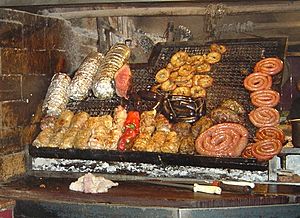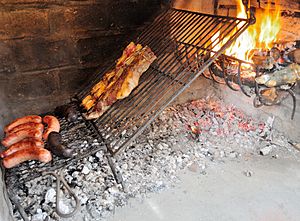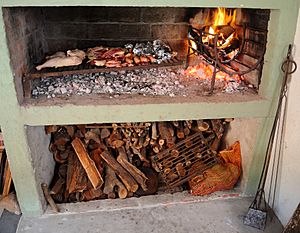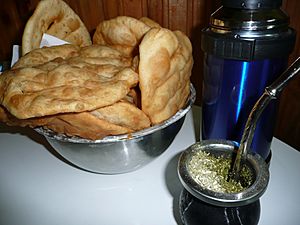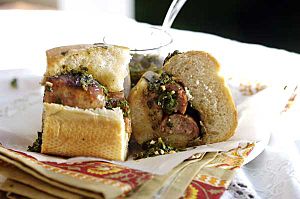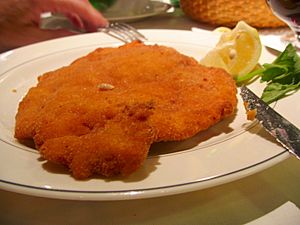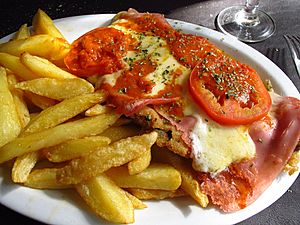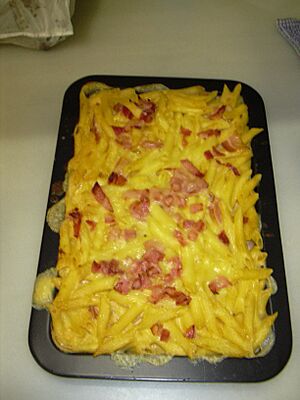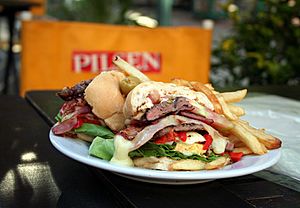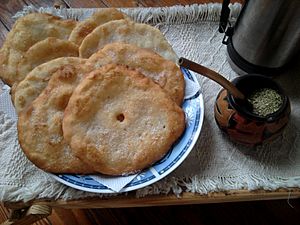Uruguayan cuisine facts for kids
Uruguayan cuisine is a mix of foods from many European countries. It especially includes dishes from Mediterranean areas like Spain, Italy, Portugal, and France. Other countries like Germany and Scotland also influenced the food because people moved from there to Uruguay. Uruguayan food is mostly shaped by these waves of immigrants, especially Italians, who arrived in the late 1800s and early 1900s. Native American foods are not as common in the main diet.
Spanish influences are very strong. Desserts like churros (fried pastry cylinders, often filled with dulce de leche), flan, and alfajores came from Spain. You can also find many stews called guisos or estofados, rice dishes like paella, and bean stews like fabada. Traditional pucheros (stews) are also from Spain. Uruguayan fish dishes, such as dried salt cod (bacalao), calamari, and octopus, come from the Basque and Galician regions of Spain, and also from Portugal.
Because of the strong Italian influence, many famous Italian pasta dishes are popular in Uruguay. These include ravioli, lasagne, tortellini, fettuccine, and gnocchi. While pasta can be served with many sauces, Uruguayans created a special one called Caruso sauce. This sauce is made from cream, meat, onions, ham, and mushrooms. It is very popular with sorrentinos and agnolotti pasta.
German influences are also found in Uruguayan food, especially in sweet dishes. Pastries called bizcochos are German in origin. Croissants, known as medialunas, are very popular. They come in two types: made with butter or lard. Other German-style treats include Berlinese (called bolas de fraile) and rolls called piononos. Many German pastries were given local names and often filled with dulce de leche. Even dishes like chucrut (sauerkraut) are now common in Uruguay.
The main foods in Uruguay are meat and animal products. This mostly means beef, but also chicken, lamb, pig, and sometimes fish. The most common ways to cook meats and vegetables are boiling and roasting. However, modern cooking has made frying popular, seen in dishes like milanesas and chivitos. Wheat and fruits are often served fried (like torta frita and pasteles). Some wild meats like mulitas (armadillos) and carpinchos (capybaras) are also eaten. Local fruits like butia and pitanga are used to flavor a drink called caña.
Uruguay has many native plants and animals, but most are not used in food, except for yerba mate. Uruguayan meals almost always come with fresh bread. Bizcochos and tortas fritas are often eaten when drinking mate. Mate is the national drink. It is made from the dried leaves and twigs of the yerba mate plant. Hot water is poured into a special cup called a gourd, and the drink is sipped through a metal straw called a bombilla. Wine is also a popular drink. Other traditional drinks include caña (a type of rum), grappa, lemon-flavored grappa, and grappamiel (a grappa and honey drink). Grappamiel is very popular in the countryside, especially on cold mornings.
Popular sweets include membrillo (quince jam) and dulce de leche. Dulce de leche is a sweet paste made from caramelized milk. It is used to fill cookies, cakes, pancakes, and alfajores. Alfajores are shortbread cookies with dulce de leche or fruit paste in the middle. Dulce de leche is also used with flan.
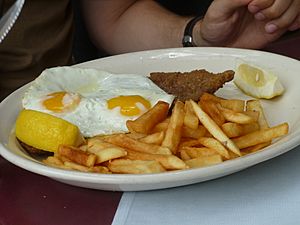

Pizza is a big part of Uruguayan food. Local pizzas often look more like an Italian calzone than traditional Italian pizza. Common Uruguayan pizzas include pizza rellena (stuffed pizza), pizza por metro (pizza by the meter), and pizza a la parrilla (grilled pizza). While Uruguayan pizza comes from Neapolitan cuisine, the Uruguayan fugazza (a type of focaccia) comes from Genoa. However, it is prepared differently, and adding cheese to make fugaza con queso or fugazzeta started in Argentina or Uruguay.
Sliced pizza is often served with fainá, which is made from chickpea flour and baked like pizza. It is common to eat pasta with white bread, which is unusual in Italy. This is because bread is cheap, and Uruguayan pasta often comes with a lot of tuco sauce (a meat sauce) and estofado (stew). Less often, pasta is eaten with pesto (a green basil sauce) or salsa blanca (Béchamel sauce). In the 20th century, people in Montevideo pizzerias often ordered a "combo" of moscato (a sweet wine) with two stacked pieces of food: pizza on the bottom and fainá on top. Even though both pizza and fainá are Italian, they are never served together in Italy.
Polenta comes from Northern Italy and is very common in Uruguay. Unlike Italy, this cornmeal dish is eaten as a main meal with tuco (meat sauce) and melted cheese or ham.
Contents
- History of Uruguayan Food
- Appetizers and Snacks
- Side Dishes
- Sauces to Try
- Barbecue and Salads
- Asado: The Uruguayan Barbecue
- Popular Uruguayan Beverages
- Hearty Stews and Puchero
- Minutas: Uruguayan Fast Food
- Pizzas, Pastas, and Breads
- Uruguayan Sandwiches
- Sweets for Mate Time
- Desserts to Enjoy
- Images for kids
- See also
History of Uruguayan Food
The history of Uruguayan food goes back to the way of life of the gauchos. They lived by farming and raising animals, a system brought by the Spanish and Criollos when Europeans first arrived. Native peoples did not stay in one place, and Uruguay was mainly a remote port.
The only lasting settlement back then was by Franciscan friars in a place now in Brazil called Misiones. Their goal was to teach Christianity to the native people. The tradition of drinking mate started during this time. The monks made a drink from yerba mate leaves, which the Guarani people used to chew.
Cattle were later brought to the region by Hernando Arias de Saavedra.
The first immigrants were poor families from Buenos Aires and the Canary Islands. They brought their empanadas and cocidos (stews). Everything was sold from pulperías, which were both stores and saloons.
The asado (barbecue) tradition came from the gauchos who lived in the countryside. They were descendants of the first families who had no land or home and made a living by raising cattle.
Portuguese and Brazilian influences were added during Portuguese rule. Feijoada (a bean stew) became part of the other guisos.
Food was simple and based on Spanish traditions until the late 1800s and early 1900s. That's when many families, mostly from Italy and Spain, immigrated. More people came after World War I and World War II from all over Europe and the Middle East, including Germany, Russia, Italy, and Armenia. This immigration brought many new dishes, like pasta, Russian salad, and countless types of pastries from France and Germany, leading to treats like chajá and alfajores.
Appetizers and Snacks
Uruguayan cuisine has many appetizers and snacks. The most traditional one is the picada, which is probably like the Spanish tapas. For everyday meals, matambre relleno and lengua a la vinagreta are also popular.
Traditional Drinks Before Meals
Common traditional drinks in Uruguay include grappa and caña. Grappa is often enjoyed before a meal, and caña is a type of liqueur. Drinks made with caña are thought to help with digestion. Other popular drinks are martini, vermouth, whisky, medio y medio (half and half), uvita, sangria, and wine.
Medio y medio is a special mix of dry wine and sparkling wine, or sparkling wine and caña. Uvita is a strong wine with caña that tastes like marsala wine.
Main Appetizers
Picada
Picada is often the first course of a typical asado (barbecue) and is eaten with traditional drinks. It includes cheese (usually Uruguayan Colonia cheese), olives, longaniza (sausage), salami, chips, and salted peanuts. Peanuts and other snacks are served in small bowls, while other items are served on a wooden board with slices of bread.
Matambre Relleno
Matambre relleno is a common dish in the Río de la Plata region, found in both Uruguay and Argentina. It is made from matambre, a cut of meat similar to a flank steak. Thin slices of meat are rolled around spinach, carrots, and boiled eggs. This roll is tied, sewn, boiled, then pressed, and eaten cold.
Lengua a la Vinagreta
Lengua a la vinagreta (Spanish for tongue with vinaigrette) is a cold dish made from beef tongue. The tongue is peeled and boiled, then served with a vinaigrette sauce. This sauce is made with chopped boiled eggs, parsley, garlic, onions, olive oil, and vinegar.
Pescado en Escabeche
Escabeche is a way of preserving food common in Spain and Spanish-speaking countries. It uses a mix of oil and vinegar as a marinade that also keeps the food fresh.
Pescado en escabeche (escabeche fish) is a cold dish often made from Argentine hake. The fish is battered and fried, then simmered in a vinaigrette made of oil and vinegar. Sliced onions, carrots, whole garlic cloves, and black pepper are added to the sauce.
Side Dishes
Food is mostly eaten with bread, and sometimes with rice, salad, or chips. Along with asado, common sides include chorizo (sausage), morcilla (blood sausage), offal, stuffed peppers, and papas al plomo (roasted potatoes).
Sauces to Try
The most famous sauces in Uruguayan cooking are chimichurri, salsa criolla, and salsa Caruso.
Picantina
Picantina is a spicy sauce often added to hot dogs (panchos), hungaras (spicy sausages), choripanes, and hamburgers. You can often find it in street food carts, where it's called 'carritos'. It tastes like hot mustard or mayonnaise.
Mojo
This sauce shares its name with the Spanish mojo. It's a simple sauce made with garlic, oil, parsley, oregano, paprika, water, and salt. It's added to asado while it cooks and sometimes on the plate. Mojo is different from chimichurri because it has water and less paprika.
Chimichurri
Chimichurri is like a mix between a vinaigrette and a pesto. It's made with parsley, chopped garlic, oregano, red pepper flakes, paprika, oil, vinegar, and salt. Along with salsa criolla, it's a favorite for asado.
Salsa Criolla
Made with finely chopped tomatoes and onions, oil, and salt, salsa criolla is used to top asado, choripan, and sometimes hot dogs.
Salsa Golf
[[Salsa golf|Salsa golf]] means "golf sauce" in Spanish. It is a cold, thick sauce very popular in Argentina. People often use it as a condiment, which is something you add to food to make it taste better.
The story goes that a famous doctor named Luis Federico Leloir invented this sauce. It happened in the mid-1920s at a golf club in a beach town called Mar del Plata. Dr. Leloir was tired of eating shrimp with just mayonnaise. So, he asked a waiter to bring him different ingredients. He tried mixing things like vinegar, lemon, mustard, and ketchup. His favorite mix was ketchup and mayonnaise. His friends at the golf club liked it too and named it salsa golf. Soon, this tasty sauce became famous and spread to nearby Uruguay.Mostaza La Pasiva
La Pasiva is a famous restaurant chain in Uruguay known for its fast food. Their specialties are hot dogs and hungaras, and they are also famous for their chivito. Mostaza La Pasiva is a white, hot mustard served with hot dogs. It's made with beer, starch, mustard seeds, pepper, salt, and vinegar. It's not sold in stores but sometimes given as a gift to customers. This mustard is also used with puchero meat.
Salsa Caruso, Estofado, and Tuco
These three are important pasta sauces, among other foreign pasta sauces. Salsa Caruso was created to honor the opera singer Enrico Caruso and became very popular, especially with cappelettis a la Caruso. Estofado is a stewed version of ragu made from steaks, sometimes eaten alone. Tuco, when made with chopped meat, is similar to a bolognese sauce.
Barbecue and Salads
Salads
Uruguayan cooking has many salads. The most typical is ensalada criolla.
Ensalada Criolla
This salad is common in the southern south cone region, with small differences. Most versions, like the Chilean salad, always include onion and lettuce. The Uruguayan version also has tomato and is served with a simple vinaigrette made of oil, vinegar, salt, garlic, and oregano. It's a basic salad and perfect with asado.
Ensalada Rusa
This salad is more like the Polish sałatka jarzynowa than the typical olivier salad. It contains potatoes, carrots, and peas mixed with mayonnaise.
Ensalada de Papa y Huevo
This is a simple potato and egg salad, or sometimes potato and onion salad, or just potatoes with mayonnaise and parsley.
Ropa Vieja
Ropa vieja (Spanish for "old clothes") is similar to an old Spanish salpicon. It uses leftover asado meat, usually the best cuts, chopped with vegetables like potatoes or ensalada criolla. It's not the same as the Cuban ropa vieja, which is a different stew.
Salpicon de Ave
Another salpicon dish, chicken salpicon is made with chicken, eggs, and potatoes.
Palmitos con Salsa Golf
This is simply heart of palm, sometimes rolled in ham slices and served with salsa golf.
Watercress Salad
This salad is basically watercress, olive oil, and lemon juice.
Asado: The Uruguayan Barbecue
Asado is more than just a meal; it's an event! The meal and the cut of meat itself are also called asado or tira de asado.
In most Uruguayan homes, you'll find a special grill on the patio called an asador. This structure is made of iron and brick. Most asadores are quite large, with a chimney, a place for firewood, and a big grill for the meat. Hot Embers from the firewood are placed under the grill.
In many towns and cities, street vendors sell asado. Their small barbecue grills are called medio tanque (half barrel) because they are made from a cut-open steel drum. Asado cooked this way is often sold on the street as a snack or light lunch.
In bigger cities like Montevideo, markets often have grill stations where you can order and eat asado right at the counter. It might be served with offal, sausages, and other small dishes. It's usually enjoyed with lager beer for lunch.
The person who cooks the asado is also called the asador.
Asado is often started with traditional drinks like vermouth, uvita, and medio y medio. Then comes an appetizer called picada, followed by chorizos, morcillas, and some offal.
Ingredients for Asado
A complete Uruguayan asado includes chorizo (sausage), morcilla (blood sausage), pulpon, entraña, tira de asado (ribs), cow gizzards, chinchulines (small intestines), chotos (large intestines), and kidneys. Chicken might also be included.
Sometimes, especially on holidays, pork, fish, and lamb are eaten instead of beef, making a different kind of asado.
How Asado is Prepared
A typical asado takes one to two hours to cook. If you're barbecuing a whole pig, it can take at least four hours!
The asador starts the fire in a special burner. Once the fire is going, the meat is salted and seasoned. Spices might include oregano, garlic, paprika, parsley, and mojo sauce. The first hot embers are placed under the grill, the meat is put on, and more embers are added as needed. The meat cooks slowly and gets smoky on the asador. Mojo is added regularly for flavor.
The meat is served with bread and salads. Sauces like mojo, chimichurri, and Uruguayan salsa criolla are also served. Drinks include wine, clerico, and sangria.
Asado Variants: Asado con Cuero
Asado con cuero (barbecue with its hide) is a favorite in the countryside and also popular in the capital. It's a more complex way of cooking asado because the whole animal is barbecued, even with its hide, though the bones are removed. This method started with the pampa people, who could easily roll up the meat and take it with them if they needed to move quickly.
Popular Uruguayan Beverages
Typical Uruguayan drinks are mate, caña, uvita, grappamiel, and medio y medio (half and half).
Grappa
Grappa was brought by Italian immigrants in the 19th century. Grappamiel and grapa con limon were created in Uruguay because of this Italian influence.
Uvita
Uruguayans developed a taste for wine from Mediterranean influences, as well as sangria and clerico. Uvita (little grape) is a strong wine similar to marsala wine.
Medio y Medio
Literally meaning "half and half," medio y medio is a mixed drink. It's either caña and sparkling wine, or dry wine and sparkling wine. It is made and sold under the brand Roldos.
Mate: The National Drink
Mate is enjoyed at any time and for any reason, often with tortas fritas or bizcochos. Drinking mate is a special ritual of friendship. Carrying a thermos of hot water makes it easy to share. Even on hot summer days, people say it's refreshing.
Uruguay is the world's top consumer of mate, with people drinking 6.8 kilograms of yerba mate per person each year. This is 1.2 kilograms more per person than Argentina.
Yerba mate is also consumed as mate cocido (cooked mate). When prepared with milk, it's called mate de leche or mate con leche.
Grapa con Limon
Grappa is sold under different brands, but San Remo is the most well-known. It is made and bottled by ANCAP. When grappa is mixed with lemon, it's called grapa con limon.
Caña
Caña is an amber-colored drink similar to aguardiente, made from sugar cane. Its caramel color comes from aging in barrels. It is made and bottled under the brand name De los 33.
Grappamiel
Hearty Stews and Puchero
Uruguayan guisos or stews are perfect for cold days and are very filling. The most famous is puchero, followed by buseca, guiso carrero, guiso de fideos (noodle stew), estofado, and feijoada.
Spanish cooking has a strong influence on Uruguayan stews. There are also Italian and Portuguese-Brazilian influences, with the latter coming from the Luso-Brazilian invasion of Uruguay.
Puchero
Uruguayan puchero is similar to other versions in the region, coming from Spanish tradition. It's like a hearty soup where the solid ingredients are separated from the broth after cooking. First, the broth is eaten as a soup, and then the other tasty ingredients are eaten with bread.
A typical puchero can have all kinds of meat cuts with bones, skirt steak, ossobucco, bacon, cabbage, sweet corn, onions, celery, carrot, sweet potato, squash, and potatoes.
All these ingredients are cut into large pieces, cooked, and served. The broth is used to make different soups with small noodles, rice, or other grains.
It's common for people to mash their cooked vegetables on their plate, adding oil if they like. They also often take the caracu (bone marrow) from the ossobucco bone and spread it on bread.
Mustards from the Savora brand and La Pasiva are used to flavor puchero meat.
Ensopado
This dish is popular in rural areas for summer days. It has broth, noodles, and thick slices of meat, chorizo sausage, and tocino (bacon) all boiled together.
It has few vegetables because it's meant not to ferment on hot days. So, it only has a few onions and squash.
Its name comes from the verb ensopar (to moisten, to make soupy).
Guiso Carrero
It's sometimes hard to tell what food is Argentinian and what is Uruguayan because of their shared history. Guiso carrero is not just a dish but also part of Uruguayan folklore. It's a delicious meal with meat, butterbeans, and noodles.
Chefs say it's a tasty stew with potato, sweet potato, noodles, squash, onion, tomato, beans, and the best meat.
Guiso carrero is served with red wine, bread, and grated cheese.
If guiso carrero doesn't have noodles, it's called guiso de porotos. If it doesn't have beans, it's called guiso de fideos or ensopado.
Buseca
Buseca comes from Italian tradition and is also known as cazuela de mondongo in Spain.
Its main ingredient is mondongo, which is tripe (cow's stomach). It is pre-cooked and boiled with meat, chorizo, tomato, and potato.
Feijoada
This dish comes from Portuguese Brazilian influence and is very popular throughout Brazil. Feijoada is also popular in Uruguay (though not in Argentina). It's a black bean stew. Unlike the Brazilian version, Uruguayan feijoada often includes potatoes (besides bananas and fariña) and is more often made with beef than pork. It's also common to find chorizo and chorizo Colorado in Uruguayan feijoada.
Bacalao
Bacalao is a dry fish stew made from dried and salted cod, chickpeas, onions, potatoes, tomato sauce, and parsley. It is usually eaten in Uruguay during Easter, following a Spanish Catholic tradition.
Italian-Style Stews
Italian-style stews are also very popular in Uruguayan cuisine. Ragu-style stews like albondigas con papas and estofado are still favorites.
Niños Envueltos
Literally meaning "wrapped children," this stew has small wraps about the length of a human finger. They are made from loin slices filled with bacon, spinach, and carrots. These are then boiled in a tomato sauce and served with peas and boiled potatoes.
Estofado
Estofado can be made with chicken or beef. It's called estofado de pollo with chicken and estofado de carne with beef. It's a dish with meat and chorizo or chicken, stewed in tomato sauce. It's sometimes served with boiled potatoes or pasta.
Albondigas con Papas
Spanish for meatballs with potatoes, albondigas con papas is a dish made from meatballs boiled in tomato sauce with potatoes and peas.
Albondigas con papas are eaten with cheese and parsley.
Minutas: Uruguayan Fast Food
Minuta is the local name for fast food in the Río de la Plata region.
Common side dishes include fried eggs, croquetas, French fries, purée (mashed potatoes), and salads.
The most famous minutas are milanesas, refuerzos like choripanes, chivitos, pizza, and faina. The bauru is also common near the Brazilian border.
Choripan
Choripan is a mix of the Spanish words for sausage (chorizo) and bread (pan). It's also called chorizo al pan (sausage on bread). It's a sandwich made with barbecued chorizo (sliced in half to fit), mayonnaise, ketchup, tomato, lettuce, onions, and more.
Hungaras
Hungaras are like hot dogs, boiled sausages but spicier, thinner, and longer. Like hot dogs, they are served on bread and found as street food. You can also buy them in supermarkets.
Milanesas
Milanesa (from Italian cotoletta alla milanese) is a thin, breaded cutlet. It can be veal, chicken, or fish.
Breading involves three steps, and their order changes the milanesa. Many old restaurants in Montevideo start with egg, so the last dip is also egg. This method, from Galician and Spanish cooks, creates an egg film when fried. This is a unique version, as most homemade milanesas and those served elsewhere use a different breading order.
Milanesas are also sold in butcher shops at every stage before frying: sliced, tenderized, or already breaded and ready to cook.
A typical milanesa dish comes with fried eggs (or "a caballo" – "horse riding" – when the egg is on top), french fries, or salad. How the milanesa is served gives the dish its name. It can be "a caballo," "a la napolitana" (Naples style), or "al pan" (a milanesa sandwich).
A milanesa a la napolitana, which is not from Naples, is a milanesa topped with tomato sauce, ham, and finely grated mozzarella cheese (in that order).
A milanesa al pan is a sandwich made with milanesa, felipe bread (a type of bread roll), tomato slices, lettuce, mayonnaise, bacon, ham, cheese, and olives. If a milanesa al pan is larger, it's cut in half and called milanesa en dos panes (double bread). Homemade and street versions of this dish are called refuerzo de milanesa and are made with baguette instead of felipe bread.
Postas de Pescado a la Marinera
Often served near ports, pescado a la marinera is battered fish fry commonly served with lemon slices.
The batter is made from beer (preferably Patricia brand), flour, and salt.
Panchos (Hot Dogs)
Hot dogs are called panchos and come in two sizes: cortos (short) and largos (long).
La Pasiva is a restaurant chain in Uruguay known for its panchos. They are famous for their La Pasiva mustard sauce, which comes with every pancho order. They also serve local specialties like panchos con panceta (panchos with bacon) and panchos porteños.
- Panchos con panceta: A grilled hot dog wrapped in a spiral of sliced bacon and served on bread.
- Panchos porteños: A hot dog wrapped with mozzarella cheese and served on bread.
Croquetas
Croquetas are croquettes made with potato and ham, rice and ham, or béchamel sauce and ham.
Empanadas
Empanadas are a type of pastry that started in Spain. In Uruguay, empanadas are usually baked and have different fillings. Empanadas de carne are filled with ground meat, chopped boiled eggs, garlic, and onions. They can be "dulces" (sweet, with raisins) or "saladas" (salty, with olives). Empanadas de pollo are made with ground chicken meat. Empanadas de jamon y choclo or humitas are filled with ham and corn. Empanadas de queso y cebolla are filled with onion and cheese. Empanadas de dulce, or empanadas de membrillo, are filled with quince cheese.
Empanadas should not be confused with pasteles, which are similar baked goods.
Buñuelos
Buñuelos are different types of fried dough balls. The most common are buñuelos de acelga (chard), buñuelos de sesos (with brain), buñuelos de manzana (apple), and buñuelos de banana (banana).
Sweet buñuelos are served with cane sugar sprinkled on top.
Pizzas, Pastas, and Breads
Pizza, pizza-like bread, and pasta are part of everyday food in Uruguay, brought by Italian traditions.
Pizza
Uruguayan-style pizza is usually rectangular and has a thicker crust that rises higher than typical Neapolitan pizza. It's often sliced into squares, similar to pizza al taglio or Sicilian pizza. Pizzas with an even thicker crust are called "pizza de cumpleaños" (birthday party pizzas) because they are often served at parties.
Pizza can have many ingredients, but the most common are pizza (without cheese or toppings) and pizza-muzzarella (with mozzarella cheese).
Fainá
Fainás are often served in pizza bars and restaurants across the country.
It is a thin, round baked crepe made from chickpea flour. You can order "fainá de orilla" (fainá from the edge) if you want the thinnest part, or "fainá del medio" (fainá from the middle) for the thicker center.
Unlike Italy, where fainá is peppered on the plate by the crust, Uruguayans usually pepper it on the plate with white chopped pepper on the other side.
When fainá is served on top of a pizza, it's called "pizza a caballo," which means "horse-riding pizza."
Figazza
A figazza is a pizza bread without tomato sauce, topped with onions and often mozzarella cheese. It probably comes from the Genoese focaccia (where it's called fügàssa). It's also eaten in Argentina as fugazzeta.
Typical ingredients for a figazza are onions, peppers, and olives.
Fideos con Tuco
Tuco is a Uruguayan tomato sauce made with chopped meat, tomato sauce, onions, oregano, and garlic. Fideos means noodles.
Tuco can be served with any pasta, fresh or dry. The most common are tallarines con tuco (spaghetti with tuco), ñoquis con tuco (gnocchi), moñitas con tuco (farfalle), raviolis con tuco (ravioli), and canelones con tuco (cannelloni).
Canelones con tuco are covered with béchamel sauce and then with tuco.
Fideos con Estofado
Estofado and tuco can be used interchangeably for any of the mentioned noodles. However, estofado can also be a dish by itself when served alone or with potatoes.
Estofado is made by cooking meat pieces in tomato sauce for a long time.
Ñoquis (Gnocchi)
Gnocchi, or ñoquis del 29, is a tradition of eating gnocchi every 29th of the month. This tradition came from immigrants from Veneto, Italy, and honors Saint Pantaleo, who had many miracles attributed to him.
Families and friends gather on the 29th to eat gnocchi. The tradition is for everyone at the table to put money under their plate for good luck.
Capeletis a la Caruso
Caruso sauce was invented by chef Raymundo Monti and named after the famous singer Enrico Caruso. It is a warm sauce made of cream, sliced onions, ham, cheese, nuts, and mushrooms. It is served with cappelletti.
Uruguayan Breads
- Pan de Chicharrones: Literally meaning rind bread, also called rosca de chicharrones. It's a leavened bread made with cow lard and small pieces of fried cow fat. You can find it in local bakeries, along with sweet versions without rinds, like rosca de membrillo (quince cheese-filled bread) and rosca de dulce de leche (dulce de leche-filled bread).
- Flauta: Pan flauta (flute bread) is a long bread, a type of baguette.
- Tortuga: Pan tortuga is a small, round bread with a soft crust, which is why it's called tortuga (Spanish for turtle).
- Felipe: Felipe is a small bread with a hard crust.
- Porteño: Porteño is named after the people of Buenos Aires. It's similar to Felipe but has a smaller crumb.
- Marsellés: Marsellés is named after the city of Marseille. It looks like two twin Vienna bread rolls with a harder crust, covered with corn flour.
- Pan de Sándwich: Pan de sándwich is a soft, square bread specially made for sandwiches.
Uruguayan Sandwiches
Uruguay has many different sandwiches, locally divided into two types: refuerzo (reinforcement) and sándwich. Sandwiches in the Rio de la Plata region are special because of the pan de sándwich they use. These types of sandwiches are simply called sándwiches and are commonly sold in local bakeries. The Spanish difference between refuerzo and sándwich (also seen in Mexico with torta and sándwich) is not as strong in Argentina. There, the difference is often made by adding de miga (crumby) to the latter. Famous refuerzos include chivito, choripán, and milanesa al pan.
Chivito: The Famous Sandwich
Chivito, meaning "small goat," is a very popular sandwich that started in Uruguay. Its name comes from a customer who wanted goat meat, but since goat is not commonly eaten in Uruguay, they were given this now-famous dish instead. A thin slice of filet mignon replaced the goat meat. Today, it's made with bacon, mozzarella, ham, onion, hard-boiled eggs, tomato slices, mayonnaise, olives, and bread.
Different versions of chivito include chivito en dos panes (double bread), chivito canadiense (with Canadian bacon), chivito canadiense al plato, and chivito al plato (served on a plate).
A complete chivito is served with french fries. When served on a plate, it also comes with ensalada rusa and ensalada criolla.
Choripán
Choripán is a mix of the Spanish words for sausage (chorizo) and bread (pan). It's also called chorizo al pan (sausage on bread). It's a sandwich made with barbecued chorizo (sliced in half to fit), mayonnaise, ketchup, tomato, lettuce, onions, and more.
Sándwich Olímpico
The Sándwich Olímpico (Olympic sandwich) is a very popular sandwich in Uruguay. It's made with three slices of pan de sándwich filled with ham, cheese, olives, tomato, and lettuce.
Sándwich Caliente
The Sándwich caliente (hot sandwich) or "tostado" (toasted) as it's called in Argentina, is like a croqué monsieur. It's made with two slices of pan de sánguche filled with ham and cheese, then toasted.
Jesuitas
Jesuitas are made with two layers of puff pastry filled with ham and cheese, and covered with meringue icing. This gives them a sweet and salty taste.
Sweets for Mate Time
Tortas Fritas
Tortas fritas (fried cakes) are a simple pastry, very common in Uruguay and Argentina, with many versions across South America. The recipe comes from the sopaipilla, which is thought to be from Germany but was brought to Spain by Arabs.
Specifically, tortas fritas are thin, round pieces of leavened fried bread. They are known for being sprinkled with sugar, having a distinctive hole in the center, and using cow fat for both frying and making the dough.
- A fun fact in Uruguayan folklore is that tortas fritas taste best when made and eaten on rainy days.
Bizcochos
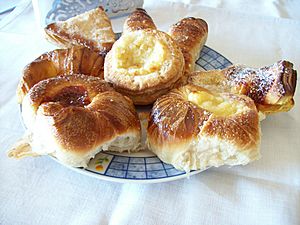
Uruguayan bizcochos are small pastries. They are different from the Spanish sponge cake of the same name, which in Uruguay is called bizcochuelo.
Bizcochos are eaten with mate, coffee, and tea. They are the most common pastry in Uruguay and are widely sold in local bakeries.
Bizcochos come in various types, like corazanes (croissants), margaritas, and pan con grasa.
Pasteles
Pasteles (pastries) are triangular-shaped empanadas. They are made from the same dough as tortas fritas, but they are puffed up using cow fat. Like tortas fritas, they are also sprinkled with sugar after frying. Pasteles are only filled with quince jam or dulce de leche.
- Tortas fritas and pasteles are commonly sold by street vendors.
Alfajores
Alfajores are two round, sweet, spongy doughs put together. They are filled with dulce de leche and covered in two ways: "chocolate" or "nieve" (snow). The "nieve" version is called that because of its white, snowy look from the meringue topping.
- Yo-yo: A layered pastry filled with Dulce de Leche and covered with chocolate on the top half. It is shaped like a yo-yo toy.
Desserts to Enjoy
Cakes
- Chajá (postre): A dessert with meringue, sponge cake, "Chajá" cream, and peaches. It was created by a well-known company in the city of Paysandú.
- Isla Flotante: Made with egg white and sugar, and served with zabaione (a light custard).
- Massini: Made of two layers of pionono (a thin sponge cake), filled with whipped cream, and topped with caramelized sabayon.
- Bizcocho Borracho: A dessert from Spain, it's a spongy dough soaked in a sweet liquor syrup.
Sweet Treats
- Garrapinyades: A very popular treat made with peanuts covered in cocoa, vanilla, and sugar, similar to whole-nut pralines. They are sold in small bags in downtown streets.
- Damasquitos: Jelly apricot candies, a special sweet from the city of Minas.
- Yemas Acarameladas: Egg candy made mainly with egg yolks, vanilla, and sugar. They are spherical, about one inch wide, and covered with a thin layer of hard, clear, caramelized sugar.
- Zapallo en Almíbar: Squash in syrup.
Cookies
- Churros: These came from Spain and are just like Spanish churros, but some in Uruguay have fillings like custard cream or Dulce de Leche.
Custards and Ice Creams

- Dulce de Leche: A sweet treat made from milk and sugar. It is used in many Uruguayan desserts.
- Dulce de Membrillo: A sweet, jelly-like preserve made from quince fruit.
- Budín Inglés: In English, 'English pudding'. A pudding with fruits and nuts, very popular during Christmas and New Year's Eve.
- Flan: A rich custard dessert with a layer of soft caramel on top, different from crème brûlée.
- Martín Fierro: A simple dessert of a slice of cheese and a slice of quince preserve (dulce de membrillo).
- Ricardito: Also very popular, this is a cream-filled treat covered with chocolate on a waffle base. It comes in different versions and is sold in most kiosks in individual boxes.
Images for kids
-
A typical Uruguayan parrillero
See also
 In Spanish: Gastronomía de Uruguay para niños
In Spanish: Gastronomía de Uruguay para niños


